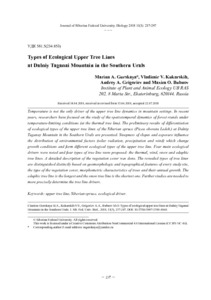Типы экологических границ леса на горе Дальний Таганай на Южном Урале
Скачать файл:
URI (для ссылок/цитирований):
https://elib.sfu-kras.ru/handle/2311/72135Автор:
Гурская, М.А.
Кукарских, В.В.
Григорьев, А.А.
Бубнов, М.О.
Gurskaya, Marina A.
Kukarskih, Vladimir V.
Grigoriev, Andrey A.
Bubnov, Maxim O.
Дата:
2018-09Журнал:
Журнал Сибирского федерального университета. Биология. Journal of Siberian Federal University. Biology; 2018 11 (3)Аннотация:
На примере горы Дальний Таганай (хр. Таганай, Южный Урал) проведено выделение типов верхних
границ леса на основе ведущего экологического фактора, влияющего на морфометрические
характеристики ели сибирской (Picea obovata Ledeb.). Крутизна склонов и экспозиция
оказывают влияние на распределение экологических факторов (солнечной радиации, осадков
и ветра), что в свою очередь ведет к изменению условий произрастания и формированию
разных экологических типов верхних границ леса. Следовательно, температура – основной,
но не единственный фактор, влияющий на динамику верхней границы леса. Выделено четыре
типа границ: термическая, курумная, ветровая и снеговая. На каждой границе дано детальное
описание растительного покрова. Показаны различия между границами по геофизическим и
топографическим характеристикам склонов, растительному покрову, морфометрическим
характеристикам деревьев и их годичному приросту. Наиболее протяженной оказалась
курумная граница, наименее протяженной – снеговая Temperature is not the only driver of the upper tree line dynamics in mountain settings. In recent
years, researchers have focused on the study of the spatiotemporal dynamics of forest stands under
temperature-limiting conditions (at the thermal tree line). The preliminary results of differentiation
of ecological types of the upper tree lines of the Siberian spruce (Picea obovata Ledeb.) at Dalniy
Taganay Mountain in the Southern Urals are presented. Steepness of slopes and exposure influence
the distribution of environmental factors (solar radiation, precipitation and wind) which change
growth conditions and form different ecological types of the upper tree line. Four main ecological
drivers were noted and four types of tree line were proposed: the thermal, wind, snow and edaphic
tree lines. A detailed description of the vegetation cover was done. The revealed types of tree lines
are distinguished distinctly based on geomorphologic and topographical features of every study site,
the type of the vegetation cover, morphometric characteristics of trees and their annual growth. The
edaphic tree line is the longest and the snow tree line is the shortest one. Further studies are needed to
more precisely determine the tree line drivers

